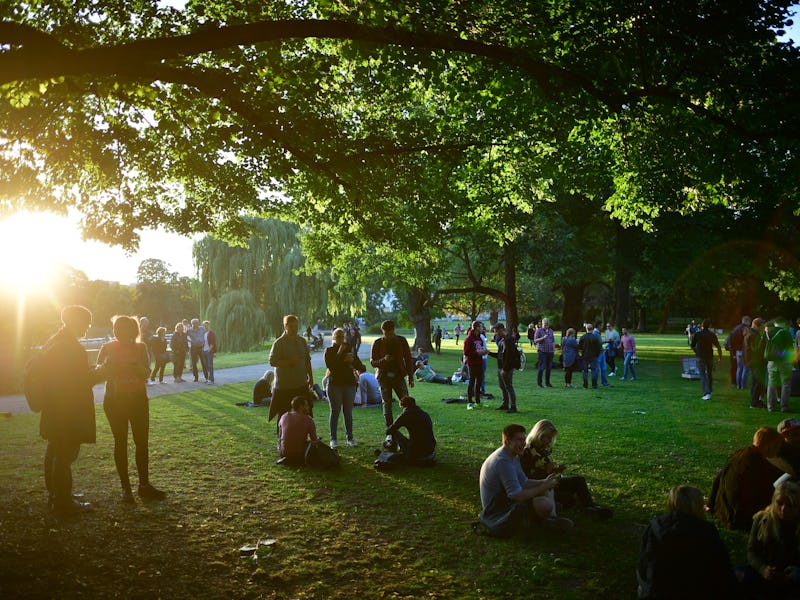'Pokemon Go' Taught Me the History of My Adopted Home
Gaming might help soften the blow of gentrification.

Between the streets of Broadway and Saint Nicholas at 170th Street in uptown Manhattan, there’s a small, triangular park named after Juan Pablo Duarte, one of the founders of the Dominican Republic. I live right next to Duarte’s Square, but I probably would have spent my life ignorant of his place in the history and hearts of my neighbors if it weren’t for Pokémon Go.
I would like to think otherwise, but it’s true.
New York City Parks didn’t choose Duarte at random — 48 percent of Washington Heights was born in another country, and two-thirds of those foreign-born residents are from the Dominican Republic. There are plenty of residents like me, brought north by cheaper rent and the medical programs at Columbia University’s teaching hospital, but the Heights’s locals are still overwhelmingly Dominican-American.
I’ve learned about the present-day culture of the neighborhood over the past year I’ve lived there – largely through the people I see every day. What I missed, however, are the marks of history and art covering the walls on side streets and in parks. Pokémon Go makes missing those pieces of culture close to impossible.
The Duarte Square PokéStop, for example, includes the info Duarte Square, named for Juan Pabo Duarte, Founder of the Dominican Republic. Close by is the site of Hilltop Park, which tells players about how the park was “dedicated to Washington Heights by the New York Yankees to mark the exact location of home plate in Hilltop Park, home of the New York Highlanders from 1903 to 1912, later renamed the New York Yankees.”
The Yankees relocated to the other side of the Harlem River in 1923, but the team is still connected to Washington Heights, both historically and in the present. The Yankees’ legendary third baseman (and current designated hitter) Alex Rodriguez, nicknamed “A-Rod,” is a Dominican-American who grew up in Washington Heights, and in 2004 returned to his home town to play ball alongside the iconic Derek Jeter. Lou Gehrig, the early 20th century slugger who played 17 seasons for the Yankees, was also born in Washington Heights.
Neither of those tidbits are enough to gain a full understanding of the area’s history; but it’s enough to launch someone’s education about the history and culture of the place they live.
As soon as I hit level 5 in the game, I went to the closest Pokémon Gym. It’s the dog run at J. Hood Wright Park, and I had noticed earlier that it was getting a lot more use since Pokémon Go came out. I took my English Bulldog Daisy with me as a way to assure people (or myself) that I wasn’t there just for the Pokémon Go, but I didn’t need to. Even the few people who brought dogs were unabashedly playing.
An elementary school boy who went to the nearby school ran up to me and asked what team I was on, then proceeded to tell me how Team Mystic is the best (something I happen to agree with). I wasn’t the oldest person there, or the youngest. I wasn’t even the whitest. People of all ages and ethnicities were gathered around the same location, which isn’t something you see often in Washington Heights.
It later occurred to me that I wasn’t the only one going to these PokéStops. Even if all of the people dotting the grass around the dog run didn’t read the descriptors, they were going to these places in person.
That means they, like me, got to see the commissioned “Know Your Rights” mural on the side of the grocery store. It means that they got out and walked past the Latin pride painting PokéStop, and the gym on the corner of the United Palace, a theater, place of worship, and cultural arts center. It means, most of all, that people were getting outside and experiencing real life and real culture — even if it was being experienced first through a screen, and then through a quick glance up.
Living through a phone screen has its detriments. It can breed narcissism and a dependence on social media validation. A study in Psychological Science found that even taking pictures on phones ruins people’s memories of the moment.
So while people are being exposed to the culture of the neighborhood, how much each person gets out of that exposure varies.
Niantic, the company behind Pokémon Go, chose PokéStops and gyms based on data from a previous game called Ingress. Locations that were highly trafficked and popular in Ingress became gyms in Pokémon Go, while locations that were heavily trafficked, but not quite as much, turned into PokéStops. As a result, churches, murals, and other areas of cultural significance became hubs for Pokémon Go players. The location date is crowdsourced, however, so not every stop delivers cultural enlightenment.
Of course, the influx of Pokémon Go players wandering through Washington Heights could mean something else entirely: incoming gentrification. Researchers in London found that increased social media activity in low-income areas by digital-first newcomers was a better predictor of gentrification than census data. Pokémon Go players, despite the wide swath and overall diversity, are, by definition, digital first.
But perhaps getting outside and playing Pokémon Go will expose people to the culture around them. Maybe it could make them appreciate, rather than try and replace, the local businesses and the impromptu dominoes games in the middle of the sidewalk.
Duarte Square has become a markedly different place since Pokémon Go debuted. The game won’t be mind-numbingly popular forever, and things will probably go back to how they were. Hopefully, the spirit of exploration and learning about your local neighborhood lives on.